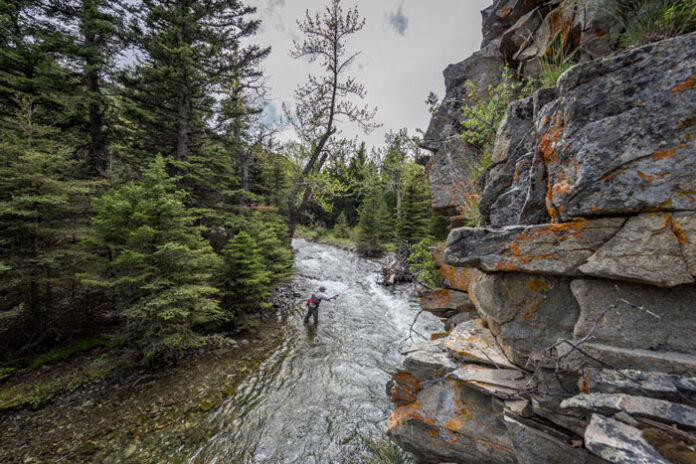Written by: The Staff of Montana Angler
It’s not the Madison or the Yellowstone, but streams like this offer great fly fishing for trout.
All photos courtesy Montana Angler
As the winter snow flies in Montana, it is easy for the mind to wander to warmer days spent exploring the intimate streams that we fly anglers hold near and dear to our hearts. Perhaps a sense of exploration pulls us toward casting in small, off the beaten path waters. Maybe it’s the typically high numbers of eager fish in a stream where a 16-inch trout is a trophy. Regardless of the reasons why we choose these smaller angling venues, there are a few things worth keeping in mind when fishing small water.
Match Your Fly Rod to the Conditions
Most of our small-stream fly fishing in Southwest Montana is done with dry flies or smaller dry/dropper rigs to trout that are on the smaller end of the size spectrum. The sheer numbers of fish that we typically expect to catch in small streams makes up for the lack of size. A great way to make the most of the smaller fish is to fish a lighter and softer fly rod. The “standard” trout rod is a 9-foot, 5-weight. Hook a 6-inch trout on on this setup, and fly-fishing quickly becomes fish-flying, as you’ll likely toss the little guy into the bushes behind you on the hook set. Downsizing to a softer and shorter rod makes for a fun, sporty fight with even the smallest of trout.

A short, fiberglass rod is perfect for small-stream trout.
One of our favorite small stream rods is a fiberglass, 7-foot 3-weight. The slower action of the glass rod loads up with even the shortest of casts, and the rod will bend deeply when a small fish is on the end of the line, allowing the angler to really feel the fish during the fight. A double-tapered fly line is perfect for the small-stream rig, as well. Casts on a small stream are rarely longer than 30 feet, and are typically within 15 feet. A double-tapered line will load the rod quickly and will roll cast in tight quarters. A fringe benefit of choosing a double-tapered line for your small stream setup is that, after a season of use, you can remove the line, turn it around, and then you’ve got an identical taper on virtually unused line at the back end.
Short, stout leaders are typically adequate for small-stream fishing as well. The eager trout are rarely leader-shy, especially in rougher pocket water. Fishing the shortest and heaviest leader that is practical is both beneficial to the fish and to the angler. Since it doesn’t take as long to land the fish, it goes back in the water quickly and without unnecessary stress. Plus, the fly fisher loses fewer flies to the ever-present bushes and trees that seem to line the streams at the most inopportune times.

You don’t need to carry more than a single box to fish all day.
Small-Stream Flies
Choosing flies that can handle the abuse of being struck time and time again with as little maintenance as possible is a key factor in small-stream fly selection. Buoyant dry flies that are tied with synthetic materials like foam, rubber legs, and poly yarn will always hold up better and float longer than those tied with natural materials. Typically, small-stream fish are less picky eaters, as well. Basic attractor patterns excel, whether it’s a dry or nymph. Beadhead nymphs typically do better in pocket water, as they drop quickly in the water column, and the added flash of the bead likely gets more attention from the trout.
Types of Holding Water
“Leave no stone unturned” is a great philosophy for fishing small waters. Every break in the current–whether it’s a shelf, seam, log, boulder, undercut, foam line, or anything suspicious–can hold a fish. One bend or run in a small stream can have a dozen or more targets to probe before moving on. Cover the water thoroughly before moving upstream, and you may surprise yourself at how many fish can be in different spots, all within reach.

Pocket water, pools, and runs are often in close proximity.
Some holding water in small streams can look incredibly promising, but getting a fly in the water can be a challenge sometimes because of brushy banks, overhanging willows, and log jams. Getting creative with one’s casting can be the difference between hooking that trophy trout behind the log under the bushes and going home having only caught just the eager little guys.
When faced with difficult casting situations, the angler must remember that the fish don’t care how you cast. They just care that you get your fly into their feeding lane. No matter how unorthodox the cast may seem, what does matter is that it gets your fly to the fish. The classic “bow-and-arrow” cast is a fine example. There is really no casting involved with the bow-and-arrow; the angler simply holds the bend of the hook with a short length of leader out the rod tip, bends the rod, and “slingshots” the fly into the water. Another somewhat ugly but effective technique is the “water-load” cast. Simply put, the angler lets the fly drag downstream and then uses the water tension pulling against the line to load the rod and flip the fly upstream into the holding water.

Move fast and light on midsummer days.
Travel Light!
Another advantage to the occasional small stream day is that you can leave the “everything-but-the-kitchen-sink” mentality at home. Most small-water fishing can be done with one or two fly boxes and a couple necessities. Taking a full hip pack or vest is usually unnecessary. It’s refreshing to travel light and just bring a fly box with an assortment of general dries and nymphs, a couple spools of tippet, nippers, floatant, and a hemostat.
Small stream fishing is typically a summertime game, so wet wading is a great way to keep cool on a warm day as well. Good, slip-resistant wet-wading shoes, lightweight pants, and a sun shirt are perfect for a few hours of small stream angling. The added mobility gained from not wearing waders will be appreciated if you encounter any fast, bouldery water, as well.

Sometimes you discover an outsize trout that can make your whole trip.
A final argument for exploring Montana’s small streams is that they can be the best options during the hottest times of the summer, when high temperatures can lead to river closures to protect the fish. Picking a small stream on the map and just going exploring is a great way to get outdoors and still get a trout fix during the dog days.
Most streams in Southwest Montana hold trout, and some there are some absolute gems are out there just waiting to be discovered. The highlight of any small-stream fishing day is finding that extra large fish that’s inevitably lurking somewhere in the stream. An 18-inch fish on any river is a great catch, but in a small stream that 18-incher could be the fish of a lifetime.
Montana Angler is an Orvis-Endorsed Fly-Fishing Expedition based in Bozeman, Montana.
Credit: Source link






























